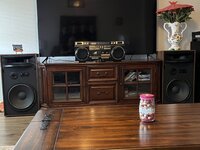I owned many of the 'collectible' boomboxes of the 80's & 90's and many of the Lasonic models. I also tried the GPO Brooklyn, the GPO Manhattan and the newest Lasonic 931 with Bluetooth. When I saw this Aiwa, I had to try it. I had very limited expectations. However, I am so very glad I did. This is labeled "Aiwa", but seems to actually be an extension of Leotech, a Chinese company which, purportedly, pursues a mission of manufacturing higher end quality hifi equipment. This Aiwa has been previously released under other brand names in other countries. The outward appearance looks the same, minus slight differences in colors and trims. Are the interior components the same? I believe so, but cannot state so for certain.
BUILD QUALITY:
This Aiwa is built very well. Very sold feel. Heavier, denser plastic shell, well secured with larger than typical hardware. Reminds me of the original JVC KaBooms, which were all plastic, but were very solidly built. Even with their large excursion woofers, the KaBooms never rattled or sounded hollow. I also admire how Aiwa reinforced the rear cabinet panel. They actually use the woofers, with their solid steel frames, to brace the rear panel, with a foam pad sandwiched in-between. the result is quite surprising. No vibration of the cabinet at all. The rear panel feels very solid, via this design and all the extra supports and ridges reinforcing the enclosures.
Design:
Until the mid-80's, boomboxes typically featured 'open-backs', to allow air to circulate. However, this also allowed sound to emanate from the rear, reducing bass response via sound wave cancellation and phasing issues. Aiwa was actually one of the first to attempt a boombox with a built-in fully enclosed speaker. The Aiwa CS-880U was a game changer. A one-piece model with high-end electronics and a fully enclosed sub-enclosure, featuring dual 5" woofers, dual 1" cone tweeters and a center 6" passive radiator. Very nice overall sound.
This new Aiwa features separate fully enclosed sub-enclosures. Essentially, it is a pair of separate speakers, fused into a one-piece unit. Thoughtfully designed. A 5" woofer which actually looks like a 'real' woofer. I measured the woofer's free-air resonance at 62 Hz! Excellent! The GPO models incorporate nice looking woofers, but I measured their resonances to be much higher, above 85 or 90 Hz. The enclosures are rear ported. But these ports actually work. The port is a 1.5" with a 7" 'elbow shaped' duct, resulting in a calculated enclosure resonance of approximately 55 Hz. Very good. And the port is flared, which further reduces air excitation (chuffing). The tweeters are 0.75" true fabric soft domes. Unlike most other boomboxes, the tweeters are not excessive. They actually sound very flat and even. They are crossed over around 8Khz, nominally.
Old analog styled tuner works fine. I can receive stations I listen to when driving around the city. Analog FM signals are finicky. Results will vary. It is the nature of the beast.
CD player works very well. The spring-loaded suspension is a very smart addition, further ensuring vibrations do not reach the CD. I had an 80's Pioneer turntable which featured a double shock-reduction construction, consisting of inner springs supporting the turntable, for the same purpose. Nice. This CD player works a little differently than others I've owned. The CD will spin and then stop, as music is playing. I imagine the sound is buffered, to further avoid vibration caused issues. This design may also lengthen motor life. Interesting.
The tape deck operates well. The retro-styled 'piano keys' feel solid. On other retro boomboxes, the keys are thin and feel as if they may break under the pressure. The deck works fine and allows recording onto tape from many sources. However, this deck is so-so in performance. Look for my separate review, detailing all specs, pros and cons.
Aux-in worked fine for playing music and testing.
Bluetooth connects quickly and works very well.
I did not bother with the other inputs.
Sound Performance:
Overall sound quality is very good. Bass is well extended, down to the 40-50 Hz range. Midrange is clear, full and very smooth. Treble is detailed and clean. No distortion, even at higher levels.
Appearance:
I purchased the black unit. I like the 'old-school' look of the 'aluminum-chrome' version, but the other versions have funky red and blue decals by the mode switches, which reminds me of the old Lasonics. I like the clean high-tech look of this black & gold version. The gold trim is reminiscent of the old Marantz hi-end components from back-in-the-day. Very elegant and sophisticated. Sweet!
This Aiwa AI7012 is a keeper. I will write a separate review, just detailing my testing of this unit. Highly Recommended.
BUILD QUALITY:
This Aiwa is built very well. Very sold feel. Heavier, denser plastic shell, well secured with larger than typical hardware. Reminds me of the original JVC KaBooms, which were all plastic, but were very solidly built. Even with their large excursion woofers, the KaBooms never rattled or sounded hollow. I also admire how Aiwa reinforced the rear cabinet panel. They actually use the woofers, with their solid steel frames, to brace the rear panel, with a foam pad sandwiched in-between. the result is quite surprising. No vibration of the cabinet at all. The rear panel feels very solid, via this design and all the extra supports and ridges reinforcing the enclosures.
Design:
Until the mid-80's, boomboxes typically featured 'open-backs', to allow air to circulate. However, this also allowed sound to emanate from the rear, reducing bass response via sound wave cancellation and phasing issues. Aiwa was actually one of the first to attempt a boombox with a built-in fully enclosed speaker. The Aiwa CS-880U was a game changer. A one-piece model with high-end electronics and a fully enclosed sub-enclosure, featuring dual 5" woofers, dual 1" cone tweeters and a center 6" passive radiator. Very nice overall sound.
This new Aiwa features separate fully enclosed sub-enclosures. Essentially, it is a pair of separate speakers, fused into a one-piece unit. Thoughtfully designed. A 5" woofer which actually looks like a 'real' woofer. I measured the woofer's free-air resonance at 62 Hz! Excellent! The GPO models incorporate nice looking woofers, but I measured their resonances to be much higher, above 85 or 90 Hz. The enclosures are rear ported. But these ports actually work. The port is a 1.5" with a 7" 'elbow shaped' duct, resulting in a calculated enclosure resonance of approximately 55 Hz. Very good. And the port is flared, which further reduces air excitation (chuffing). The tweeters are 0.75" true fabric soft domes. Unlike most other boomboxes, the tweeters are not excessive. They actually sound very flat and even. They are crossed over around 8Khz, nominally.
Old analog styled tuner works fine. I can receive stations I listen to when driving around the city. Analog FM signals are finicky. Results will vary. It is the nature of the beast.
CD player works very well. The spring-loaded suspension is a very smart addition, further ensuring vibrations do not reach the CD. I had an 80's Pioneer turntable which featured a double shock-reduction construction, consisting of inner springs supporting the turntable, for the same purpose. Nice. This CD player works a little differently than others I've owned. The CD will spin and then stop, as music is playing. I imagine the sound is buffered, to further avoid vibration caused issues. This design may also lengthen motor life. Interesting.
The tape deck operates well. The retro-styled 'piano keys' feel solid. On other retro boomboxes, the keys are thin and feel as if they may break under the pressure. The deck works fine and allows recording onto tape from many sources. However, this deck is so-so in performance. Look for my separate review, detailing all specs, pros and cons.
Aux-in worked fine for playing music and testing.
Bluetooth connects quickly and works very well.
I did not bother with the other inputs.
Sound Performance:
Overall sound quality is very good. Bass is well extended, down to the 40-50 Hz range. Midrange is clear, full and very smooth. Treble is detailed and clean. No distortion, even at higher levels.
Appearance:
I purchased the black unit. I like the 'old-school' look of the 'aluminum-chrome' version, but the other versions have funky red and blue decals by the mode switches, which reminds me of the old Lasonics. I like the clean high-tech look of this black & gold version. The gold trim is reminiscent of the old Marantz hi-end components from back-in-the-day. Very elegant and sophisticated. Sweet!
This Aiwa AI7012 is a keeper. I will write a separate review, just detailing my testing of this unit. Highly Recommended.



